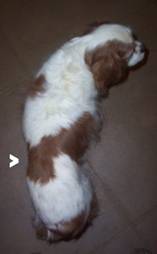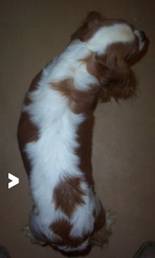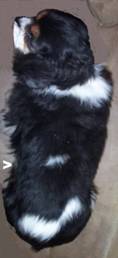Cavalier King Charles Spaniels
Est. 1976
Cavalier Care
Click on section below you wish to visit
|
1. Preparation
Let's stop and think about feeding for just a minute. Forget
about advertising. Forget about what we have been told. Let's
put on our thinking caps, use a bit of common sense, and think
for ourselves. Think about what is considered good food for
humans. What does a cow or horse eat? How about zoo
animals--what do they eat? Do animals get viruses like us? Of
course! Do animals get degenerative diseases such as cancer like
us? Of course? Do they have an immune system like us? Of course!
Do you believe the immune system is influenced by diet? Of
course! If we eat better, do we tend to be healthier? Of
course! Which is healthier for humans--highly processed food
such as hot dogs, potato chips and candy -or- unprocessed food
such as chicken, potatoes and fruit/vegetables? We all know the
answer to that one!
Is there ANY reason to believe our dogs are completely different
from humans, farm animals or zoo animals? They get sick like
us. They get cancer like us. They get arthritis like us. They
have an immune system like us. In fact, dogs share much of the
same DNA with humans and we are more alike to each other than
either of us are to mice! And their immune system IS affected by
diet--just like ours.
Now how about quality of ingredients. Which is healthier--fresh,
inspected whole chicken -or- the diseased and/or otherwise
leftover parts such as carcasses, beaks, skin, feathers and
such? Is it healthier for us to eat whole grains or highly
processed rice flour? Do vegetables contribute phytochemicals,
nutrients and other things that enhance health? Is there any
reason to believe this wouldn't apply to other mammals such as
the dog?
Now, grab a bag of dog food and look at the ingredient list. How
many ingredients do you recognize? How many are a bunch of
chemical names? (LOTS!) Those chemical names are ALL the added
vitamins and minerals. Why were all those vitamins and minerals
added to the dog food? Could it have something to do with the
fact that dog food has been so highly processed/cooked that
there is little nutrition left in it? So little that the
vitamins and minerals have to be added BACK into the food to
make it nutritionally correct? Could this stuff actually be GOOD
for our dogs? Think about it! Do you think taking that lovely
chicken, rice and salad dinner--baking it in your oven for hours
until all the water is evaporated, then feeding it to your
children along with a vitamin/mineral supplement would be as
good for your children as feeding it to them fresh and
whole--with ALL the nutrients still intact, including the ones
we don't know about yet?
NOT ON YOUR LIFE!
Dogs are much healthier on fresh food, just as we humans
are. For some reason dog food companies have done their best to
convince us otherwise, but if we use common sense we know
better. The best thing to feed your dog is fresh, whole food.
Unfortunately, dogs do need a different balance of nutrients as
compared to humans. And they tend to be smaller so a balanced
diet is more critical as shortages are more like to show up
quickly. Little research has been done so far on how to feed
dogs fresh food properly. It can be a rather tricky thing to do.
Luckily we have two options that work for now. (1) We can feed a commercially prepared whole foods diet. There are companies who make fresh whole food dog diets and flash freeze them. We can buy them and keep them in the freezer until ready to be used. Then we can thaw and feed. Here is a link to a good site that lists some of the best: https://www.dogfoodadvisor.com/best-dog-foods/raw-dog-food/
These foods are completely formulated and balanced according to
the same AAFCO guidelines as dog kibble. These are our best
alternative to a completely homemade diet and the only whole
foods diet I recommend until we have done more research on how
to feed our dogs.
(2) We can feed a top-quality dog kibble along with a small
amount of vegetables. More information on how to choose a
top-quality dog kibble will follow.
Somewhere along the line the pet food companies convinced both
the vets and us that THEIR food is the best for our dogs. But if
we use common sense we can see this cannot be true.
There are many different high-quality kibbles. Some of my
present favorites are Fromm and Earthborn Holistic.
I would never, EVER feed a typical grocery store bought dog
kibble as their quality is quite inferior to the above dog
kibbles. This includes Iams and Science Diet which I consider
very poor quality as compared to the ones I've mentioned
(compare the ingredients to see why!). I will NOT feed a Puppy Food either. My dogs get only a quality Adult Food. At one time dog kibble was so poor in quality that if you did not feed a puppy food, the puppy would not get the nourishment it needed. Today the problem has reversed. Puppy foods are so powerful they actually cause the bones of a puppy to grow more quickly than the surrounding tissues are able to. This causes uneven development and may exaggerate any genetic predisposition to skeletal problems such as hip dysplasia or patellar luxation. Feed a high-quality adult kibble ONLY.
FEEDING DIRECTIONS
Puppies between 8 and 16 weeks of age do quite well on 3 meals a
day. They start out with about a large handful of kibble for
each meal or about 1/4 cup. At about 3 to 6 months of age you
may begin feeding your puppy twice a day, about 1/2 cup or so
each time. Somewhere between 10 and 18 months of age you may
begin feeding just once a day--with some really good eaters you
may need to feed just once a day by 6 or 7 months of age.
Each time you feed your puppy, put the food down for
approximately 15 minutes. If the puppy hasn't finished it after
15 minutes, pick it up and put it away until the next feeding
time. Do NOT try to feed in between. Refrigerate if you are
feeding a commercially prepared whole foods diet. Do not worry
if your puppy appears thin. Puppies are just like humans. Some
are very thin while growing up and some are not. It is highly
unlikely your puppy will starve itself unless it is already
ill. A puppy that grows slowly is best--there is no first prize
for gaining full size as early as possible! Puppies who grow
slowly are more likely to be able to develop muscle and tissue
at the correct rate to keep up the bone development. Of course,
some puppies are gluttons! Be careful not to overfeed a glutton.
As adults some Cavaliers may only eat 1/2 cup of food per day,
others may eat as much as 1 full cup of food per day. I do not
suggest feeding an adult Cavalier twice a day unless you are
quite resistant to temptation. Why? Cavaliers do
not eat much! Half of very little is almost nothing! Nearly
every owner I've known who tried to feed an adult twice a day
ended up with an overweight Cavalier. When they try to divide
1/2 or 2/3 cup of kibble into two servings the amount barely
covers the bottom of the pan--so they add just a little bit more
so they don't feel as though they are starving their Cavalier. A
little bit more every meal eventually ends up being a lot more
and their Cavalier becomes overweight. With one meal a day the
amount looks to our eyes as though it is a half way decent
amount and we are much less likely to add just a little bit more
each day.
Due to MVD, being overweight is nearly a death sentence for a
Cavalier. I guarantee you the best way to prolong your
Cavalier's life is to keep its weight to a MINIMUM! Not
overweight even a little bit. THIN! If your Cavalier is even a
little bit overweight, it will hasten the onset of MVD and
death. Do not allow this to happen.
HOW MUCH DO I FEED AND IS MY DOG OVERWEIGHT?
Your vet is not the person to ask! Over the years I have been
amazed to find out that vets are very reluctant to tell an owner
their dog is overweight until the dog is quite overweight--till
the dog is so overweight it is very hard to get it off. Here are
two ways to judge if your dog is overweight.
First is the rib test. Look for a hand towel or dish towel in
your house. Fold it in half. Find a wire crate, wire fencing or
ex-pen, something with wire not spaced too far apart. Rub the
towel over the wire several times and get used to how it feels.
How does the wire feel, how easily does the towel move under
your fingers? Now rub your fingers over the ribs on your dog. It
should feel quite similar. A VERY thin amount of skin that moves
easily over the ribs--ribs which can easily be felt and
counted. If you feel some padding under the skin, the dog is
mildly overweight. If you feel a lot of padding, you have to
press a bit to feel individual ribs, and the skin doesn't move
around easily--the dog is definitely overweight.
The second test is the waist test. Stand over your dog and look
down at it while it is standing with the dog facing the same
direction as you are. You can also use your hands with this
test. As you are looking down at the dog you can see where
the ribs are. If you are not sure run your hands from the
shoulders over the ribs down to where the ribs end so you will
know just where the ribs are. After the last rib, and before the
hips, you should see a distinct indentation--a waist. If you can
barely see an indentation, the dog is mildly overweight. If
there is no indentation at all, the dog is definitely
overweight. The following are three pictures of dogs. None
are badly overweight, but they will help somewhat in teaching
you what to look for as some have a tinch more weight than they
should. I hope to get a picture of a very thin Cavalier and a
very heavy Cavalier at some point in the future.
The arrows are pointing at the waist of each dog. Dog #1 is in pretty good weight. #2 is a bit heavier and lacking some waist, but both are in decent weight. Dog #3 is definitely much heavier. The dog has no noticeable waist as you can see and needs to lose several pounds.
HOW DO I GET MY DOG TO LOSE
WEIGHT?
The same as humans--less food and more exercise!
Less Food: cut back to about 1/2 of
what you had been feeding. If you are feeding kibble, take
1/2 of what you plan on giving your dog and soak it long
enough so that it expands. Mix the dry in with the wet
expanded food. The expanded food will help your dog feel a
bit more full right after eating. Then add about 1/2 cup of
green beans---fresh or thawed frozen (canned has too much
salt) to the top and feed. The green beans are a very
low-calorie filler and quite good for your dog too!
If the dog isn't losing weight within
2 weeks, cut back on the food even more.
Some Ideas for More Exercise:
try to take your dog for a walk daily, especially if you
don't normally do so. If you can't do that for whatever
reason, attempt to play fetch or whatever with your dog for
15 minutes a day. Tether your dog to you while you are
working around the house so the dog has to go with you
instead of sleeping on the couch. Try a buster cube with a
few treats inside. That might help keep the dog busy for a
bit. Throw the dog's kibble so it has to go and get
it--either the treats or even the dog's entire meal. A |
Copyright 2023 Roycroft Cavaliers
No part of this site may be copied or reproduced without written permission.


